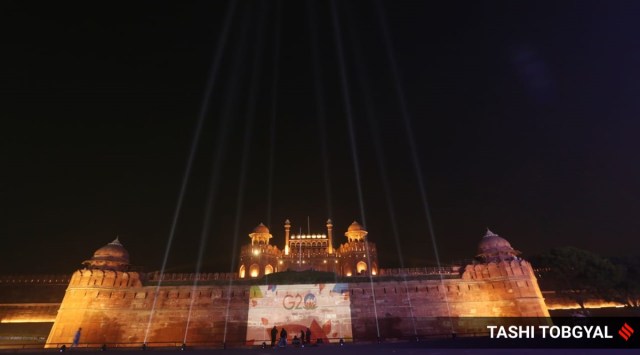📣 For more lifestyle news, click here to join our WhatsApp Channel and also follow us on Instagram
100 ASI sites get illuminated across the country for a week; know why
Some of the ASI-protected monuments which have been lit up highlighting the G20 logo include: Red Fort (New Delhi), Royal Palace (Mandu, MP), Butter Ball (Mahabalipuram, Tamil Nadu), Sanchi Stupa (MP), Nalanda (Bihar), Thanjavur Big Temple (Thanjavur, Tamil Nadu), etc
 View of an illuminated Red Fort projected with the G20 logo in Old Delhi (Express photo by Tashi Tobgyal)
View of an illuminated Red Fort projected with the G20 logo in Old Delhi (Express photo by Tashi Tobgyal)100 centrally-protected monuments under the Archaeological Survey of India (ASI), including UNESCO world heritage sites spread across the country, were lit up on Thursday for a week. As per ASI, the sites are illuminated to celebrate India assuming the presidency of G20 — an intergovernmental forum comprising 19 countries and the European Union, which works to address major issues related to the global economy.
The government agency, responsible for archaeological research and the conversation and preservation of cultural-historical monuments in the country, said on Wednesday that the 100 ASI sites will be lit up from December 1-7 and that illuminated heritage structures will bear the G20 logo. Reportedly, the size of the logo projected on the monuments will depend on the nature and design of the site.
As India assumes G20 Presidency, 100 centrally-protected monuments, including UNESCO world heritage sites spread across the country are lit up for a week bearing the G20 logo. Some Glimpses.
Red Fort, Delhi
Royal Palace, Mandu, MP
Butter Ball, Mahabalipuram, TN
Sanchi Stupa, MP pic.twitter.com/zOY8Hr734X— Archaeological Survey of India (@ASIGoI) December 1, 2022
India assumed the presidency of G20 on December 1 following which more than 200 meetings will take place across 55 locations in India.
Some of the ASI-protected monuments which have been lit up highlighting the G20 logo include: Red Fort (New Delhi), Royal Palace (Mandu, MP), Butter Ball (Mahabalipuram, Tamil Nadu), Sanchi Stupa (MP), Nalanda (Bihar), Thanjavur Big Temple (Thanjavur, Tamil Nadu), etc.
If you are planning to soak in the beauty of these heritage monuments, don’t miss out on the following lesser-talked-about sites.
Laxman Temple, Sirpur, Chhattisgarh
It is a 7th-century brick temple — mostly damaged and ruined — dedicated to Lord Vishnu. Built in 650 AD by Queen Vasata, it was discovered by Lord Cunningham in 1872 and is considered one of the finest brick temples in India. Don’t miss the garbhagriya entrance along with the tower and door carvings of the Laxman temple, which is reasonably intact.
Glimpses of @ASIGoI protected monuments lit up bearing the G20 logo. Some Glimpses.
Kumbhalgarh Fort, Rajasthan
Shankracharya Temple, Srinagar
Laxman Temple, Sirpur, Chhattisgarh
Five Rathas, Mahabalipuram, Tamil Nadu pic.twitter.com/YtGGj9966V— Archaeological Survey of India (@ASIGoI) December 1, 2022
Old High Court Building, Nagpur, Maharashtra
The Old High Court Building in Nagpur was built in 1891-93 to house the Judicial Commissioner’s office. In 1936, the office was closed and the High Court was housed in this building. After the High Court moved over to the new building in 1940, it came to be known as Old High Court Building. This two-storey building is a testament to Indo-European architecture style and covers approximately 18,228 sp meters of area.
Hemis Monastery, Ladakh
Built in 1630, this Himalayan Buddhist monastery is the biggest and most richly endowed monastery of Ladakh. It is decorated on all four sides with colourful prayer flags and is different from all other monasteries in the region. The annual Hemis festival honouring Padmasambhava is held here in early June.
Glimpses of @ASIGoI protected monuments lit up bearing the G20 logo. Some Glimpses.
Nalanda, Bihar
Thanjavur Big Temple, Thanjavur, Tamil Nadu
Metcalfe Hall, Kolkata, West Bengal
Old High Court Building, Nagpur, Maharashtra pic.twitter.com/gXegwswvnJ— Archaeological Survey of India (@ASIGoI) December 1, 2022
Jagat Shiromani Temple, Amber, Jaipur, Rajasthan
It is a Hindu temple situated in Amer in Jaipur, Rajasthan. Dedicated to the Hindu gods Meera bai, Krishna and Vishnu, it was constructed between 1599 and 1608 by Queen Kankwati in memory of her son Jagat Singh.
Metcalfe Hall, Kolkata
It is a heritage building situated in Kolkata and its architecture is reflective of the British imperial style in the middle of the nineteenth century. Inspired by and visually similar to the ancient Greek temples, it was built between 1840 and 1844.
📣 For more lifestyle news, follow us on Instagram | Twitter | Facebook and don’t miss out on the latest updates!
📣 For more lifestyle news, click here to join our WhatsApp Channel and also follow us on Instagram


- 01
- 02
- 03
- 04
- 05

























